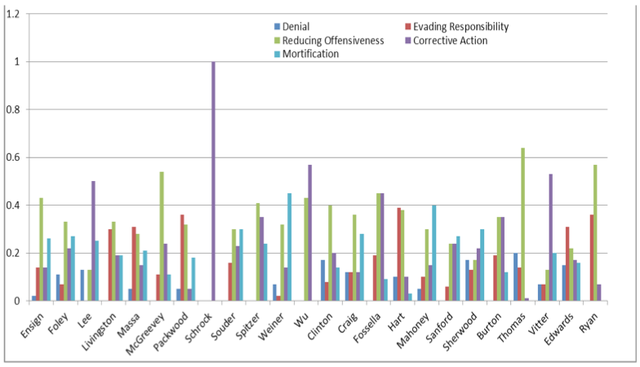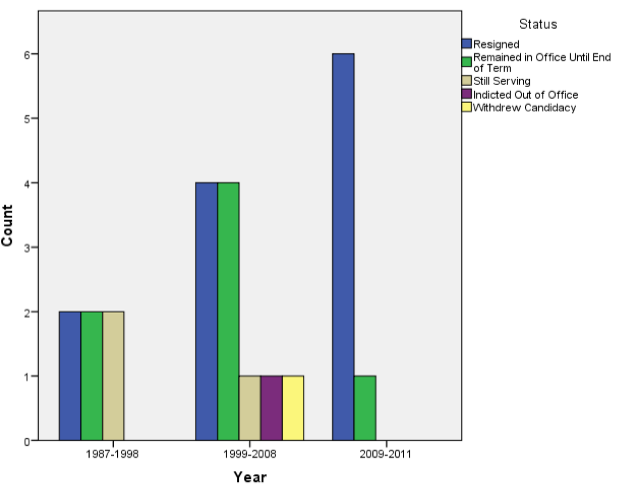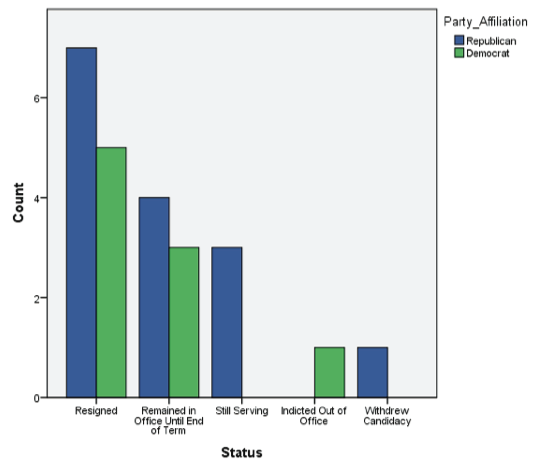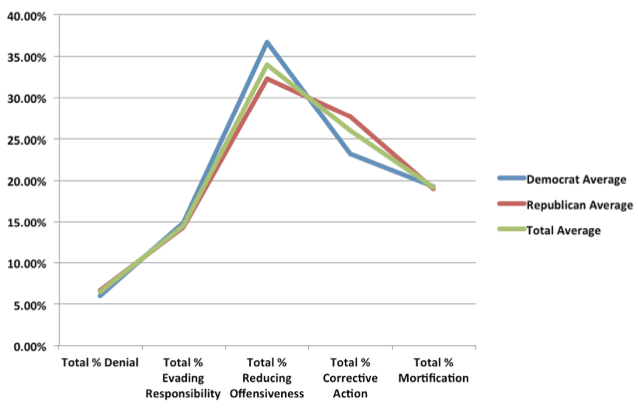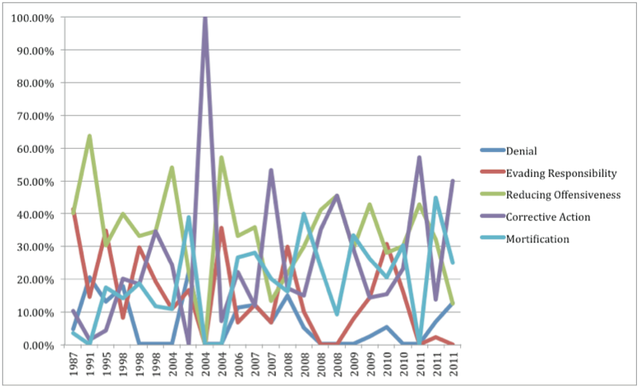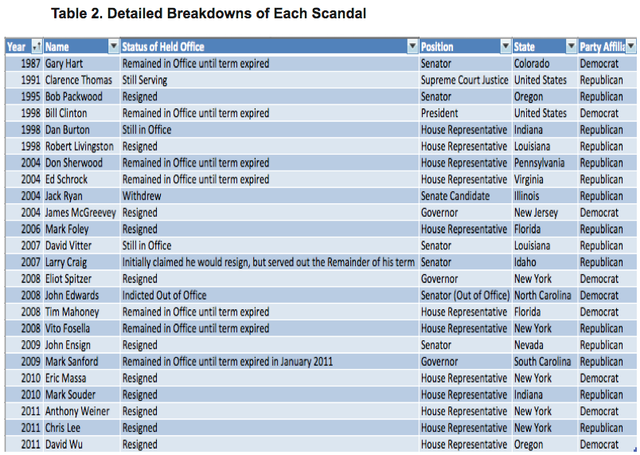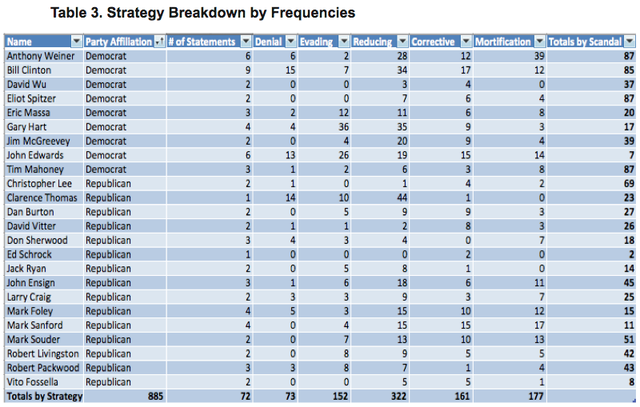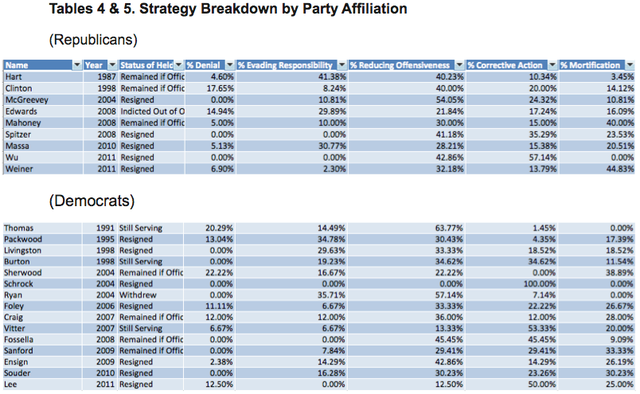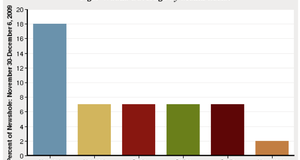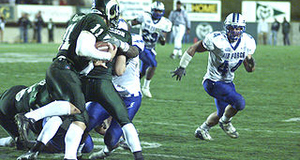From Elon Journal of Undergraduate Research in Communications VOL. 3 NO. 2Image Restoration in Political Sex Scandals: What To Do (And What Not To Do) When You're Caught With Your Pants DownV. ResultsThe research conducted in this study analyzes the various aspects of political sex scandals, their public response, and the different techniques used in image restoration. The various correlations, charts, and spreadsheets help to highlight the relationships between each variable, and explain why (or why not) certain correlations exist. The figures in Appendix demonstrate the differences between political candidates and the strategies of image restoration with which they position themselves. VI. DiscussionHypothesis FindingsHypothesis 1: The more forthcoming a politician is when responding to scandalous allegations, the more likely he is to regain popular support and ultimately be reelected. Finding: Rejected. This hypothesis was too general in that it does not consider the fact that no two sex scandals are alike, and thus the nature in which an official responds to allegations, as well as the way he or she is received by the public, is largely subjective and cannot be predicted by his initial honesty. An example of this is seen in former Governor Mark Sanford's case, in which he was extremely forthcoming and apologetic upon allegations, but was not reelected by his constituents. Hypothesis 2: The increase in Internet and new media focus has forced politicians to make more statements regarding their actions than in previous scandals. Finding: Rejected. This hypothesis was also too general in nature, assuming that there would be clear predictors of an official's response. Because the rate in which scandals are uncovered has increased substantially in recent years, the timespan of a scandal has decreased, with many officials forced to resign just hours after a story breaks. In those cases, the number of public statements made is very limited, often with just one statement being covered by various news outlets. An interesting follow-up study would break down the scandals by timespan as well as number of public statements to determine if a correlation exists. Hypothesis 3: Reducing offensiveness will be the Image Restoration strategy most frequently used in responding to scandalous allegations. Finding: Confirmed. This hypothesis is validated through the findings of this study. Reducing offensiveness was the strategy most frequently used by virtually all officials. In analyzing each table and graph, there are several noticeable trends in the strategies implemented in the formatting of their statements to the public. While there does not appear to be one distinct method that can be classified as the most effective approach in responding to the allegations, the results helped to suggest that some strategies, reducing offensiveness and corrective action, are used more often than others in drafting a response. The most significant inferences that can be made from the results are reducing offensiveness is the most frequently occurring strategy; denial is the least frequently used strategy and its rate has declined in recent years; and that the percentage of resignations in response to scandal has increased in recent years likely due to increased media scrutiny. Reducing Offensiveness as Most Used Overall StrategyAccounting for an average of 34% of the total image restoration strategies, reducing offensiveness is clearly the most commonly used tactic in the 24 scandals observed. With 322 observed statements to reduce offensiveness, there are several possible explanations for why this is true for both Republicans (32%) and Democrats (37%). First, when broken down by description, it is reducing offensiveness that has the broadest scope, with six sub-sections within its definition (Benoit, 1995, p. 77). Because within this strategy there are different tactics like attacking the accuser and bolstering, both of which were used in the majority of statements, the probability of a phrase or action falling into this category is higher than in those sections with a more limited scope. It is also possibly true, however, that officials used reducing offensiveness as a way to try and maintain a positive reputation in light of scandal. Of the five strategies Benoit outlines, it is reducing offensiveness that can be most closely linked with maintaining a positive reputation through bolstering one's positive attributes (Benoit, 1995). Figure 3 shows that of the 24 cases examined, only one official (Ed Schrock) used a low level of reducing offensiveness (between 0% and 29%), and is unique in that he only utilized one image restoration strategy, corrective action, and released only one statement following his scandal. Omitting his scandal, in fact, alters the averages for each statement (see Table 1). This data confirms Benoit's finding that "maintaining a positive reputation" remains a central goal of all communication (Benoit, 1995, p. 63). Denial as Least used Overall StrategyWith an average of 6% of the total breakdown of statements, denial is clearly the least utilized strategy of image restoration in these scandals. Only 73 out of 885 coded statements were expressions of denial, with a fairly even distribution between Republicans (7%) and Democrats (6%). Statements of denial and evading responsibility, the two strategies used least frequently, seem to have declined or remained stagnant through the years. An explanation for the infrequency of statements of denial may be that, in responding to allegations by first categorically denying them, there is the greatest likelihood that they could be caught in a lie. Relating these findings back to Benoit, it is also possible that officials are hesitant to categorically deny allegations because they understand that being caught in a lie could negatively impact their reputation (Benoit, 1995). The likelihood of officials being caught in a lie related to their scandals has greatly increased with the surge of Internet and new media outlets, many of which are dedicated to unearthing the truth. Perhaps the reason for the decline in statements of denial and evading responsibility is that officials are less able to lie by denying their involvement in a scandal than they were in the pre-Internet era. With the multitude of new bloggers and journalists that have emerged through online research, it is possible that officials are aware that they will have a more difficult time misinforming the public than officials in previous decades (Carpini, 2001). It is the development of this new media system that is likely the reason, too, that the results indicate a dramatic increase in the number of officials resigning in the wake of scandal. Increased ResignationAs Figure 7 indicates, the number of officials resigning after allegations of sexual misconduct has increased dramatically. From 1987 until 1998, only two men accused of participation in sex scandals resigned over the matter, while the number jumps to six in a two-year period from 2009 to 2011. An added effect of increased Internet and media presence, the growing number of resignations is likely congruent with the number of sex scandals that the media have uncovered. During the 11-year period examined in the pre-Internet era, there were six scandals, resulting in two resignations, two officials serving out the remainder of their term, and two representatives still currently serving today. In analyzing just the scandals that have broken out in the past two years, however, there have been seven incidents, with officials having resigned in all but one case. These results when combined with corresponding literature indicate that it is not necessarily that there have simply been more scandals in recent years, but rather more media and gossip sites that have uncovered these events. Increased scrutiny is likely the most effective explanation for both the decline of statements denying allegations or evading responsibility, as well as the growing number of officials being forced to resign over their misconduct. Outliers and Special CasesEd Schrock (2004)—Former Congressman Ed Schrock's case is the most significant outlier of the 24 scandals examined, as he made only one public statement (a press release on his behalf) using only two examples of image restoration strategy. His brief message conflicts with this study's findings that reducing offensiveness is the most frequently used strategy, and to an extent, his results skew the total averages (see Figure 11). His decision not to seek reelection was swiftly reached, and after releasing his statement, he refused to comment any further on allegations. Bill Clinton (1998)—Former President Clinton's infamous affair with Monica Lewinsky is considered by many political scientists as well as public relations practitioners an anomaly (Dagnes, 2011). His scandal is exceptional not only because it was the first public presidential sex scandal, but also because he initially denied all allegations of sexual impropriety (famously announcing, "I did not have sexual relations with that woman"), and was later found to have falsely denied those claims (Dagnes, 2011). Though he was publicly found lying, public opinion of him remained very strong throughout the scandal, and was able to remain in office despite the yearlong media frenzy and his own admission of guilt. His scandal remains an anomaly, as he had one of the highest percentages of denial (18%) and lowest percentage of mortification (14%) throughout his statements, but was still viewed favorably by most Americans (Aday, 1998). Clarence Thomas (1991)—Justice Thomas is a special case, as he is the only Supreme Court Justice to have been involved in a public sex scandal. During his Supreme Court confirmation hearings in 1991, salacious claims of an affair with Anita Hill were brought forth, which Thomas ardently denied (20% of his total statement). His case is unique, as he is the only official examined who was not subject to election by constituents for his position. It was perhaps the nature of his confirmation hearings that enabled him to gain his seat despite the national attention surrounding the affair (Thompson, 2000). As such, Thomas only made one public statement in which he denied his involvement and viciously attacked his accuser. The lifetime appointment granted to a Supreme Court justice is one reason that Thomas is one of the only three appointments still currently serving his position. Absence of Scandal from 1999-2004There is a noticeable five-year period from 1999 until 2004 in which there were no sex scandals that received significant national attention. This research does not examine the reasons that this phenomenon may have occurred, but further studies could help to explain the cause of this gap. There are several inferences that can be made from comparing the results from this study as well as existing literature on the subject. In the wake of the media frenzy surrounding President Clinton's affair, it is possible that officials were more cognizant of the media's presence, and were less likely to participate in improper actions. More likely, however, is that current events in the early 21st century (September 11, 2001, War on Terror) dictated significant media coverage, and that media outlets did not need to search as extensively for captivating stories to draw in their audience. An interesting follow-up study would examine this period for any patterns or trends, or to investigate whether there were sex scandals that simply did not garner the same national media coverage as those included in this research. Implications of Increased Media Coverage on Political AccountabilityThe research conducted in this study confirms an idea that has been largely discussed by political scientists: the increased scrutiny and lens of the media have led to increased levels of accountability for politicians. Their mistakes, transgressions, and successes are broadcast throughout America, as well as internationally, and this larger stage has forced officials to hold themselves accountable for their actions, and not to hide behind others. Press coverage has an undeniable impact on public opinion and political knowledge, and officials must always be cognizant of media presence in both their public and private lives. This notion of political accountability can perhaps explain the noticeable increase in levels of mortification in public statements (see Figure 10). When the media uncovers a salacious truth, officials must take responsibility and apologize for their transgressions in an effort to maintain a positive reputation (Benoit, 1995). Increased levels of mortification support the hypothesis that increased media coverage has led to higher standards of political accountability. With more officials apologizing for their actions rather than denying the events or attempting to evade responsibility, it appears that the public demands a certain level of accountability, and that politicians must live up to those standards. VII. ConclusionThe dramatic growth of media and Internet outlets in the last decade alone has called for an increased focus on communication and higher standards of accountability. No longer can officials hide their discretions from the public by arguing the distinction between their public and private lives. Benoit's "Theory of Image Restoration" is widely accepted as a standard of effective crisis management, as they stress the fundamental importance of communication as a response tool. If communication is a "goal-directed activity," then the statements analyzed in this research support the various goals targeted with each strategy (Benoit, 1995). Although the majority of officials relied heavily on reducing offensiveness in their responses, it is interesting to identify under which circumstances the strategies were used differently. For some, the scandals proved to be too damaging to their reputations, and they were forced to resign often a matter of hours after the story was made public. There were others who were able to weather the scandal through a combination of restoration techniques as well as their political histories and public opinions of them. While it cannot be concluded that one restoration strategy is most effective or can predict the outcome of a scandal, this research can support the growing role that communication plays in today's digital age, and that this increased media attention has forced more and more politicians to admit to their transgressions. Sex scandals in American politics have not necessarily increased in recent decades, but the rate in which they are disseminated to the public certainly has. By applying Benoit's theory to a collection of scandals, as well as analyzing their outcomes, this research can support the idea that communication is, in fact, a "goaldirected activity," and that the strategies and tactics used to respond to scandals must evolve with the changing media landscape. AcknowledgmentsThe author would like to extend heartfelt thanks to Dr. Frontani and Dr. Farganis at Elon University for their guidance and advice throughout the progression of this study. This article is the product of nearly an entire year of scholarly research and much fine-tuning, and would not have been possible without both thesis mentors, and the many dedicated Communications professors charged with reviewing and revising this work. ReferencesA Decade of Sex Scandals (2009, June 24). MSNBC First Read. Achter, Paul J. "Narrative, Intertextuality, and Apologia in Contemporary Political Scandals." Communication Journal 65 no. 4 (Summer 2000): 318-333. Aday, Sean, and Kathleen H. Jamieson. "When Is Presidential Behavior Public and When Is It Private?" Presidential Studies Quarterly 28.4 (1998): 856-60. Print. Benoit, William L. Accounts, Excuses, and Apologies: a Theory of Image Restoration Strategies. Albany: State University of New York, 1995. Print. Benoit, William L. "Image Repair Discourse and Crisis Communication." Public Relations Review 23 no. 2 (Summer 1997): 177-186. Blaney, Joseph R. and William L. Benoit. The Clinton Scandals and the Politics of Image Restoration. CT: Praeger Publishers, 2001. Print. Burns, Judith P. and Michael S. Bruner. "Revisiting the Theory of Image Restoration Strategies." Communication Quarterly 48 no. 1 (Winter 2000): 27-39. Carpini, Michael X., and Bruce A. Williams. "Let Us Infotain You: Politics in the New Media Age." Mediated Politics: Communication in the Future of Democracy (2001): 160-81. Print. Dagnes, Alison. Sex Scandals in American Politics A Multidisciplinary Approach to the Construction and Aftermath of Contemporary Political Sex Scandals. Continuum, 2011. Print. Doherty, David & Connor M. Dowling. "Are Financial or Moral Scandals Worse? It Depends." PS: Political Science & Politics 44 (October 2011): 749-757. Dowling, John, and Jeffrey Pfeffer. "Organizational Legitimacy: Social Values and Organizational Behavior." The Pacific Sociological Review 18.1 (1975): 122-36. Print. Herman Cain Suspends His Presidential Campaign (2011, Dec. 3). The New York Times, pp. A1. Just, Marion and Ann Crigler. "Leadership Image-Building: After Clinton and Watergate." Political Psychology 21 no. 2 (March 2000): 179-198. Rosen, David S. Sex Scandal America. Toronto, Canada: Key Publishing House, 2009. Print. Sanford the Latest in a Series of Political Sex Scandals (2009, June 24). NPR: Political Junkie. Seeger, Matthew W. and Donayle R. Griffin Padgett. "From Image Restoration to Renewal: Approaches to Understanding Postcrisis Communication." Review of Communication 10 no. 2 (April 2010): 127-141. Sex Scandals Through the Years: Both Parties Even (2009, June 25). Newsweek. Thompson, John B. Political Scandal: Power and Visibility in the Media Age. Cambridge: Polity, 2000. Print. Williams, Juliet A., and Paul Apostolidis. Public Affairs: Politics in the Age of Sex Scandals. Duke University Press, 2004. Print. Woessner, Matthew C. "Scandal, Elites, and Presidential Popularity: Considering the Importance of Cues in Public Support of the President." Presidential Studies Quarterly 35 no. 1 (March 2005): 94-115. AppendixFigure 1. Use of image restoration strategies by official
Figure 2. Post-scandal status of office held by year
Figure 3. Post-scandal status of office held by party affiliation
Figure 4. Average use of image restoration strategies by party affiliation
Figure 5. Image restoration strategies by year
Public Statement Transcripts by OfficialDavid Wu
Anthony Weiner
David Vitter
Eliot Spitzer
Mark Souder
Don Sherwood
Ed Schrock
Mark Sanford
Jack Ryan
Robert Packwood
James McGreevey
Eric Massa
Tim Mahoney
Christopher Lee
Bob Livingston
Gary Hart
Vito Fossella
Mark Foley
John Ensign
John Edwards
Larry Craig
Bill Clinton
Dan Burton
Suggested Reading from Inquiries Journal
Inquiries Journal provides undergraduate and graduate students around the world a platform for the wide dissemination of academic work over a range of core disciplines. Representing the work of students from hundreds of institutions around the globe, Inquiries Journal's large database of academic articles is completely free. Learn more | Blog | Submit Latest in Business & Communications |

